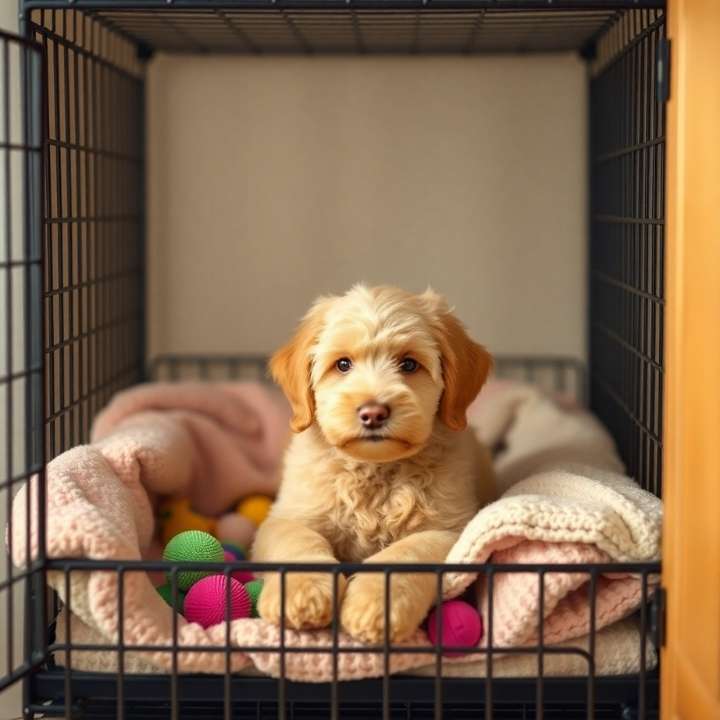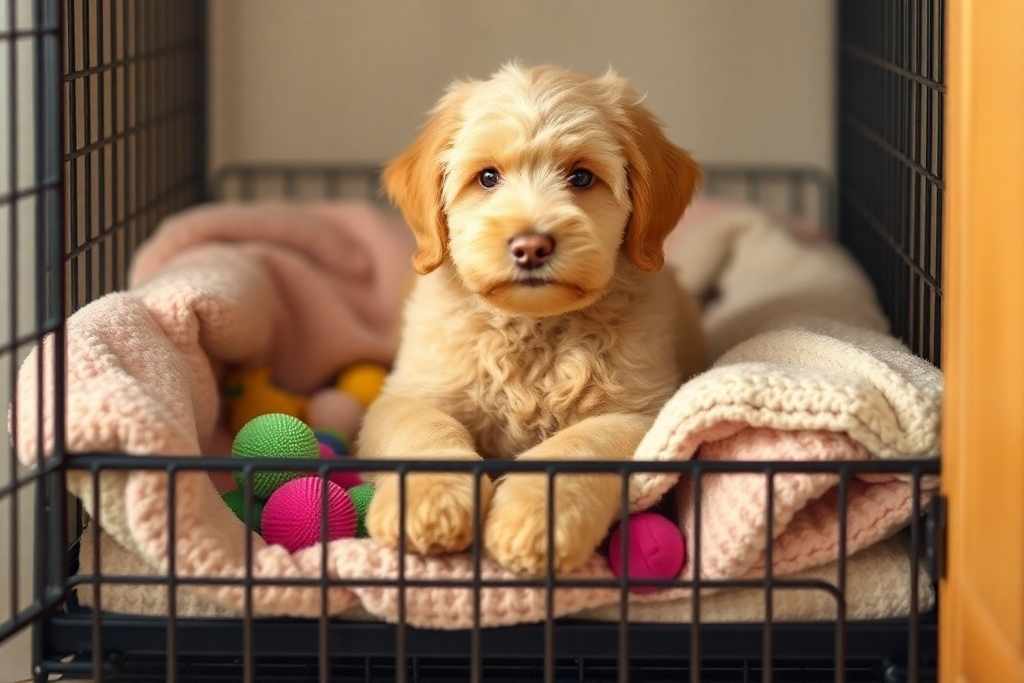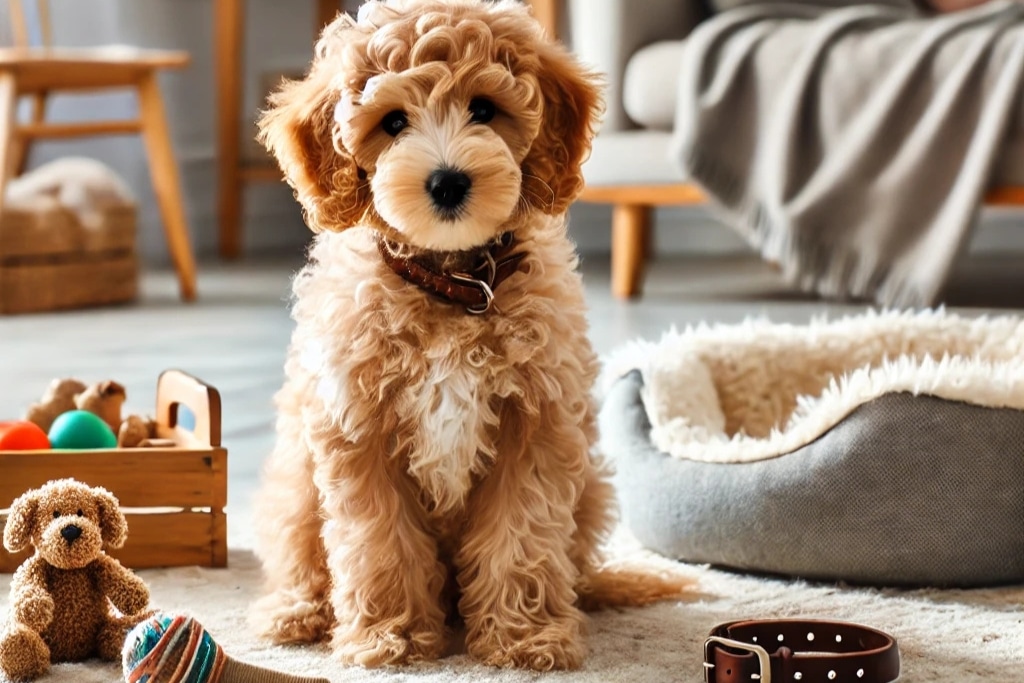As a Mini Goldendoodle owner, you know that comfort and security are key to your dog’s happiness—and that starts with the perfect crate. But with so many options out there, how do you choose the one that’s just right for your furry friend? Whether you’re new to crate training or just looking to upgrade your pup’s personal space, this guide will help you find the ideal crate size for your Mini Goldendoodle. Let’s dive in and ensure your dog gets the comfort, safety, and cozy den-like environment they deserve!
What is a Goldendoodle Crate?
A Goldendoodle crate is a secure, enclosed space designed to provide safety, comfort, and structure for your Goldendoodle. It acts as their personal haven, mimicking a den-like environment that helps them feel protected. Crates are commonly used for house training, traveling, or simply giving your dog a quiet place to relax.
For Mini Goldendoodles, which are smaller than standard Goldendoodles, choosing the right crate is essential to accommodate their unique size and needs while ensuring proper comfort and security. A crate that is too large or too small can negatively impact their overall experience.
Why Choosing the Right Crate Size Matters for Mini Goldendoodles
Selecting the correct crate size for your Mini Goldendoodle is crucial for their comfort, safety, and well-being. A properly sized crate allows your dog to stand, turn around, and lie down comfortably without feeling cramped. Here are the key reasons why crate size matters:
- Comfort: A crate that is too small can make your dog feel stressed and uncomfortable, while a crate that is too large can lead to accidents as dogs may relieve themselves in one corner and rest in another.
- Safety: A crate provides a safe environment to protect your Goldendoodle from harm, especially when you are not supervising them.
- Training Efficiency: During house training, a well-fitted crate discourages your dog from soiling inside, as dogs instinctively avoid dirtying their sleeping space.
- Travel Convenience: The right crate size ensures a smoother experience when traveling with your Mini Goldendoodle by car or plane.
Types of Crates for Goldendoodles
There are several types of crates available for Goldendoodles, each with its advantages and disadvantages. Here are the most common options:
Soft Crates
Soft crates are lightweight, portable, and made of fabric over a metal or plastic frame. These are ideal for well-trained Mini Goldendoodles during travel or temporary use. However, they may not be suitable for dogs prone to chewing or scratching as the material is not as durable as other options.
Wire Crates
Wire crates are sturdy, well-ventilated, and often come with removable dividers, making them ideal for growing puppies. They are easy to clean and allow your dog to see their surroundings, which helps reduce anxiety. However, they can be heavier than soft crates and may not provide the same level of coziness.
Wooden Crates
Wooden crates double as furniture, blending seamlessly into your home décor. These crates are aesthetically pleasing and sturdy but can be expensive and harder to move. They are best suited for adult Mini Goldendoodles that no longer need crate training.
Plastic Crates
Plastic crates are durable, easy to transport, and provide a den-like atmosphere that some dogs find comforting. They are often used for air travel. However, they can lack ventilation compared to wire crates and may feel confining for some dogs.
Average Weight and Height of Mini Goldendoodles
To choose the right crate size, you need to know the average weight and height of Mini Goldendoodles:
- Weight: Mini Goldendoodles typically weigh between 15 to 35 pounds.
- Height: Their height ranges from 13 to 20 inches at the shoulder.
Understanding these measurements helps ensure you select a crate that accommodates their size comfortably, both as puppies and adults.
Growth Stages: Puppy to Adult
Mini Goldendoodles go through several growth stages, and their crate requirements will change as they mature:
- Puppy Stage: Puppies grow quickly, so it’s practical to invest in a crate with adjustable dividers that can expand as they grow. This avoids the need to buy multiple crates.
- Adult Stage: Once your Mini Goldendoodle reaches full size (around 12 to 18 months), you can remove the dividers to allow for more space.
Being aware of these growth stages ensures you’re always prepared to meet their changing needs.
Crate Size Recommendations for Mini Goldendoodles
Ideal Crate Dimensions for Puppies
For Mini Goldendoodle puppies, a crate size of 24 inches (length) x 18 inches (width) x 21 inches (height) is generally sufficient. Make sure the crate has adjustable dividers so it can grow with your puppy.
Crate Dimensions for Adult Mini Goldendoodles
For an adult Mini Goldendoodle, the ideal crate size is typically 30 inches (length) x 19 inches (width) x 21 inches (height). This size provides enough room for them to move comfortably without feeling cramped or having excess space that can encourage accidents.
Factors to Consider When Choosing a Crate for Goldendoodles
Choosing the right crate for your Goldendoodle is essential to ensure their comfort, safety, and well-being. Goldendoodles are known for their friendly, intelligent, and active nature, and their crate should reflect these traits. Here are key factors to consider:

- Size: The crate should be spacious enough for your Goldendoodle to stand, turn around, and lie down comfortably but not too large to hinder house training efforts.
- Material: Crates come in various materials, including wire, plastic, and soft-sided designs. Each has its pros and cons, which we’ll discuss below.
- Portability: If you travel frequently, opt for a lightweight and foldable crate that is easy to carry and set up.
- Durability: Goldendoodles, especially puppies, may chew or scratch at their crates. Choose a sturdy and durable option that can withstand their energy.
- Ease of Cleaning: Accidents can happen, so a crate with a removable tray or easy-to-clean surfaces is essential.
Wire Crates: Pros and Cons
Wire crates are among the most popular choices for Goldendoodle owners. They are versatile and offer excellent visibility and ventilation. Here are the pros and cons:
| Pros | Cons |
|---|---|
| Ventilation: Wire crates provide maximum airflow, keeping your dog comfortable. | Weight: Wire crates can be heavier compared to other options. |
| Visibility: Your dog can see its surroundings, which can help reduce anxiety. | Noise: Some crates may rattle when your dog moves inside. |
| Adjustable Dividers:Many wire crates come with dividers, allowing you to adjust the space as your puppy grows. | Aesthetics: Wire crates may not blend well with home decor. |
| Durability: Sturdy and ideal for dogs prone to chewing. |
Plastic Crates: Pros and Cons
Plastic crates are another popular option, especially for travel. They are enclosed, offering a sense of security for your Goldendoodle. Here are their advantages and disadvantages:
| Pros | Cons |
|---|---|
| Privacy | Ventilation |
| Portability | Visibility |
| Durability | Size Adjustment |
| Warmth |
Soft-Sided Crates: Are They Suitable?
Soft-sided crates are lightweight and convenient, but they may not suit all Goldendoodles. Here are their pros and cons:
| Pros | Cons |
|---|---|
| Portability: Extremely lightweight and easy to transport. | Durability: Not suitable for chewers or active dogs; can be easily torn. |
| Comfort: Soft materials provide a cozy environment. | Stability: May collapse if not set up correctly. |
| Travel-Friendly: Ideal for short trips and travel purposes. | Cleaning: Fabric can absorb odors and stains, making cleaning more challenging. |
Features to Look for in a Crate
When selecting a crate, certain features can make a significant difference in usability and comfort. Adjustable dividers are invaluable for growing puppies, as they allow you to modify the crate size without needing to replace it. Proper ventilation is essential to ensure your dog’s comfort, while secure latches can prevent escape attempts. An easy-to-clean design, such as a removable tray or washable surfaces, is another must-have feature, as it simplifies maintenance and keeps the crate hygienic.
How to Measure Your Mini Goldendoodle for a Crate
To ensure the crate is the perfect size for your Mini Goldendoodle, it’s important to take accurate measurements.
Start by measuring your dog’s length from the tip of their nose to the base of their tail. This will give you the overall length of your dog, which is essential for choosing a crate that provides enough space for them to lie down comfortably. You can also try Dog Crate Size Calculator.
Next, measure your dog’s height by measuring from the floor to the top of their head or ears while your dog is standing. This will help you determine how much vertical space your dog will need inside the crate.
Once you have both measurements, add an extra 4-6 inches to each. This additional space ensures your Mini Goldendoodle has enough room to move around, stand up, turn, and stretch comfortably inside the crate. It’s important to find a crate that is neither too large nor too small just the right size to provide comfort and security for your dog.
Crate Training Tips for Mini Goldendoodles
Crate training your Mini Goldendoodle can be a rewarding process if approached with patience and positivity. Below, we’ve outlined the essential steps and considerations to ensure successful crate training for your furry friend:
Step 1: Determine the Right Crate Size
Choosing the right crate size is the foundation of successful crate training. A crate that is too small can make your Goldendoodle feel uncomfortable, while a crate that is too large might encourage them to use one corner as a bathroom. Use adjustable dividers for growing puppies to save on costs and maintain the perfect size as they grow. Always ensure the crate is spacious enough for your dog to stand, turn, and lie down comfortably.
Using the Crate for Housetraining
The crate is a valuable tool for housetraining. Dogs naturally avoid soiling their sleeping area, so use this instinct to establish a potty routine. Follow these tips:
- Set a Schedule: Take your Goldendoodle outside to potty immediately after eating, drinking, waking up, or playing.
- Monitor Time in the Crate: Puppies can only hold their bladder for a few hours, so avoid extended periods in the crate without breaks.
- Reward Success: Praise and reward your dog immediately after they potty outside to reinforce the behavior.
Ensuring a Positive Crate Experience
The key to successful crate training is creating positive associations. Follow these strategies:
- Introduce Gradually: Start by leaving the crate door open and allowing your Goldendoodle to explore it on their own. Use treats, toys, or a favorite blanket to make the crate inviting.
- Make It Comfortable: Add soft bedding and ensure the crate is in a quiet, familiar location.
- Feed Meals in the Crate: Feeding your dog inside the crate helps them associate it with positive experiences.
- Practice Short Stays: Begin with short periods in the crate while you’re at home. Gradually increase the time as your dog becomes more comfortable.
Avoiding Common Mistakes
- Never Use the Crate as Punishment: This can create fear and anxiety.
- Be Patient: If your dog whines or cries, resist the urge to let them out immediately. Wait for a moment of calm before opening the crate.
- Maintain a Routine: Consistency is key to helping your Goldendoodle feel secure and confident in their crate.
The Benefits of Crate Training a Goldendoodle
Crate training offers numerous benefits for both you and your Goldendoodle. It provides a safe and secure space for your dog to relax, especially when unsupervised. This can reduce anxiety and prevent accidents or destructive behavior around the house. Crates are also invaluable for housetraining, helping your dog develop bladder control and a consistent bathroom routine. Additionally, a crate-trained dog is much easier to travel with, as they feel comfortable and secure in their familiar space.
FAQs About Mini Goldendoodle Crates
Can One Crate Size Work from Puppy to Adult?
Yes, with an adjustable divider, a single crate can accommodate your dog’s growth from puppyhood to adulthood. This feature saves money and ensures consistency.
What Happens if the Crate Is Too Big or Too Small?
A crate that’s too big can hinder housetraining, as your dog may use one side as a bathroom. A crate that’s too small can cause discomfort and stress, leading to crate aversion.
Can Goldendoodles Sleep in Crates Overnight?
Absolutely. Goldendoodles can sleep in crates overnight, provided the crate is comfortable and they are properly crate-trained. Make sure to provide cozy bedding and maintain a consistent bedtime routine.
What if My Goldendoodle Doesn’t Like the Crate?
If your dog resists the crate, take a gradual approach. Use treats, toys, and positive reinforcement to create a welcoming environment. Never force your dog inside, as this can create negative associations.
How Long Can a Goldendoodle Stay in a Crate?
Puppies should not be created for more than 3-4 hours at a time due to their smaller bladder capacity. Adult dogs can stay in a crate for up to 6-8 hours, but always ensure they have adequate exercise and bathroom breaks.
Conclusion
Choosing the right crate for your Goldendoodle is an investment in their comfort, safety, and happiness. With the right size, material, and features, a crate can become a cherished space for your dog. Combine this with thoughtful training, and you’ll create a positive experience that benefits both you and your furry friend.
Read more: Goldendoodle Ear Infections: Causes, Symptoms, Prevention & Treatment.







